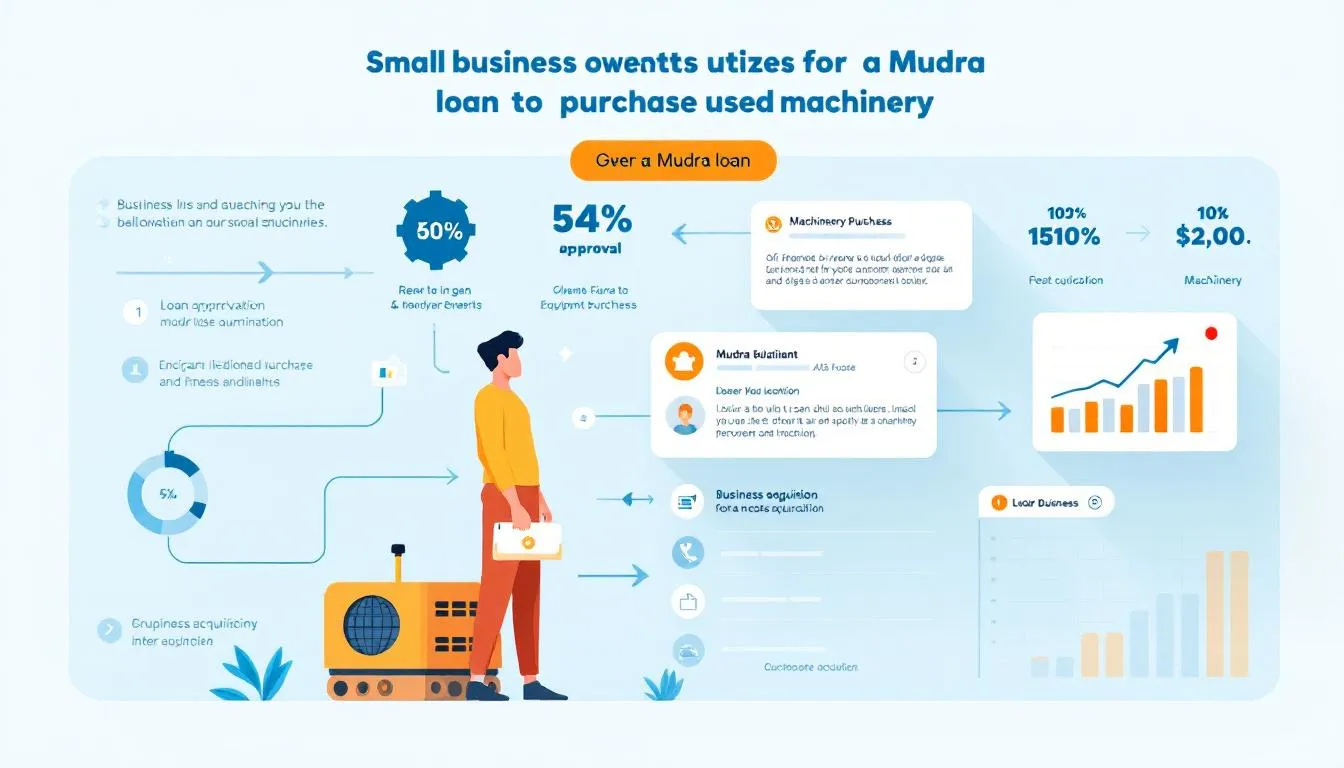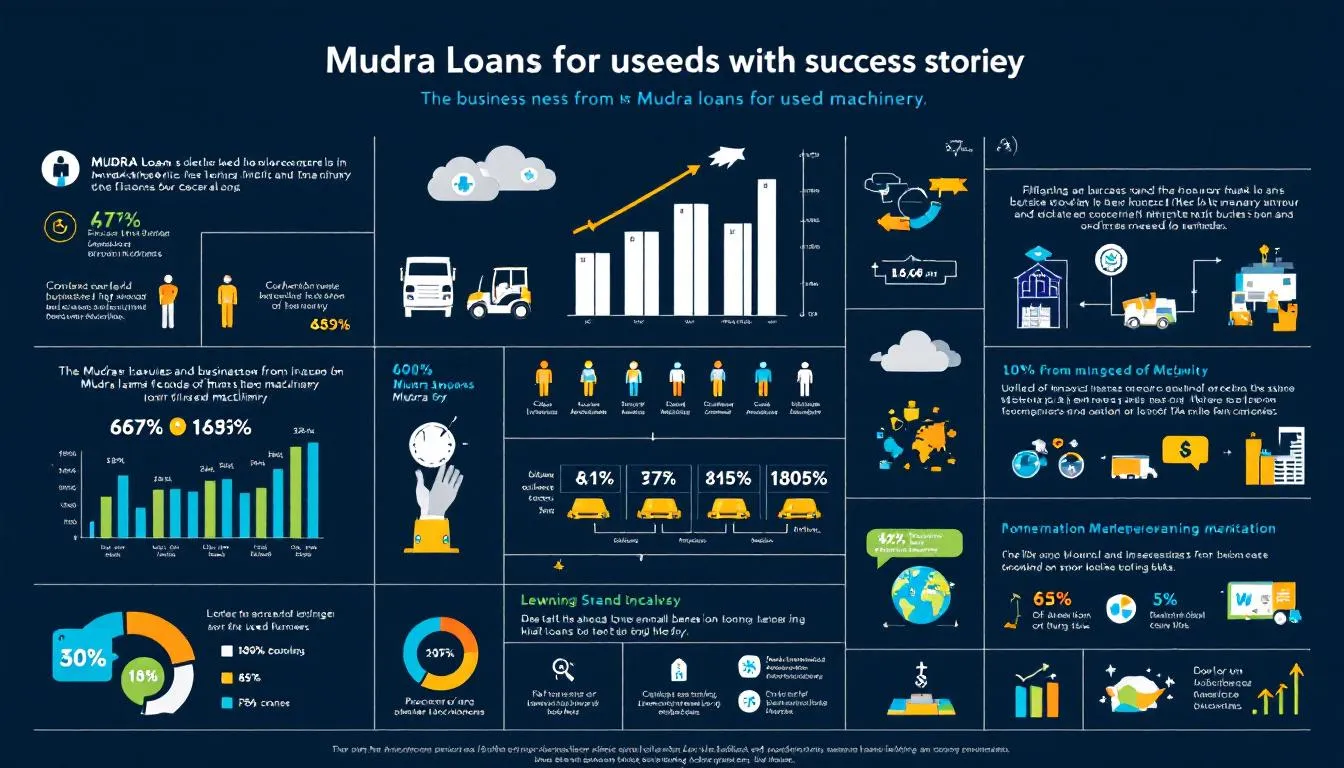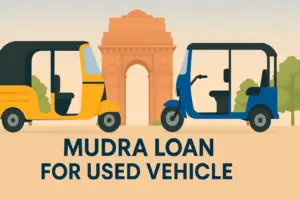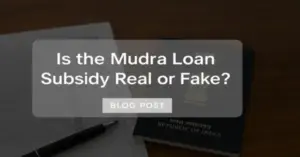Yes, you can use a Mudra Loan for used machines to buy used machinery. This article explains the eligibility criteria, required documents, interest rates, and benefits of getting a Mudra Loan for used machine.
Key Takeaways
- Mudra Loans provide up to Rs. 10 lakh for purchasing used machinery with flexible documentation requirements, subject to lender approval.
- Mudra Loans can be used as a business loan for acquiring used machinery, supporting business expansion and productivity improvements.
- Eligibility for Mudra Loans includes small to large enterprises with at least two years of operational history and necessary documentation.
- Interest rates vary among lenders, and submitting a strong project report along with proper valuation proof can improve approval chances.
Understanding Mudra Loans for Used Machinery

Mudra Loans, offered under the Pradhan Mantri Mudra Yojana (PMMY), provide financial assistance up to Rs. 10 lakh to micro-units and small enterprises without requiring collateral. These loans can cover a wide range of expenses, including the purchase of machinery and working capital needs. Mudra Loans can be availed as a term loan for machinery purchases, offering scheduled repayment options suitable for significant investments. Eligible entities include manufacturing, trading, and service enterprises, ensuring that a broad spectrum of businesses can benefit from the scheme. This scheme is particularly beneficial for businesses looking to expand or upgrade their equipment without a significant upfront investment, allowing for a loan upto rs 10 lakh and providing support for working capital needs. The scheme provides financial aid to meet the funding needs of small businesses and micro enterprises at various stages of growth.
The Mudra Loan Scheme launched is also flexible enough to accommodate the purchase of used machinery, provided the necessary documentation is in place and the lender approves the purchase. This makes it an attractive option for businesses aiming to save costs while still enhancing their operational capabilities.
Are Used or Second-Hand Machines Allowed Under Mudra Loan?
The Mudra Loan Scheme does not officially ban the purchase of second-hand machinery. However, the approval of such purchases is largely at the discretion of individual lenders. This lack of uniform clarity across financial institutions can sometimes lead to confusion for applicants.
Some banks might allow the purchase of used machinery if proper documentation is provided, while others may reject the application outright. Therefore, it’s crucial to check with your lender about their specific policies regarding second-hand equipment and the documents required for such purchases.
When and How Used Machines May Be Allowed
To get approval for a Mudra Loan for used machinery, certain conditions must be met. The machine must be bought from a registered vendor. This ensures that the equipment is legitimate and traceable.
To improve your chances of approval, ensure you have:
- A valuation certificate from a Chartered Accountant or qualified engineer to verify the machine’s worth.
- A proper invoice with applicable taxes.
- A well-justified business case and usage plan included in the project report.
Additionally, applicants should clearly outline their financing requirements in the project report to ensure the loan amount and terms align with the lender’s expectations.
Eligibility Criteria for Mudra Loan for Used Machines
To be eligible for a Mudra Loan to purchase used machinery, the applicant must first qualify under the general criteria of the Mudra scheme. Eligible borrowers are individuals or entities who meet the Mudra scheme’s requirements, such as being a micro or small entrepreneur engaged in manufacturing, trading, or service-related business—whether already operational or at the startup stage.
Eligible businesses include motorcycle repair shops, tailoring shops, dry cleaning services, papad making units, ice cream making units, and khadi activity, among other small enterprises and service providers. The scheme also supports a range of food processing and traditional livelihood activities.
Regarding agricultural activities, the Mudra scheme generally does not cover traditional crop cultivation or land improvement tasks, but it may support allied agricultural activities such as dairy, poultry, or food processing units linked to agriculture.
While the Mudra scheme itself does not explicitly prohibit funding for second-hand machines, eligibility for such a loan largely depends on the bank’s internal policies and the strength of the applicant’s documentation. Typically, banks may consider financing used machinery if the purchase is from a GST-registered vendor, a proper invoice is provided, and a certified valuation report (preferably from a Chartered Accountant) is submitted. The applicant must also clearly demonstrate in the project report how the used machine will improve productivity or contribute to business growth. Approval is discretionary and relies heavily on the credibility of the business plan and supporting documents.
Required Documents for Mudra Loan Application
Securing a Mudra Loan for used machinery involves meticulous preparation and proper paperwork. Essential documents include identity proof, address proof, and detailed financial statements. Additionally, if the machinery is purchased from a registered vendor, a valuation certificate from a Chartered Accountant or engineer and a proper invoice with applicable taxes must be submitted.
Although some banks may approve loans for used machinery without collateral, it might sometimes be necessary to provide collateral to secure the loan. Proper documentation is crucial to avoid delays or rejection of the loan application.
Interest Rates for Mudra Loans
Interest rates for Mudra Loans can vary significantly among different banks and financial institutions. These rates are influenced by various factors, including the type of business and its associated risk profile. Applicants with a strong credit score and history are generally offered lower interest rate. Mudra Loans are often provided at competitive rates, making them especially attractive for MSMEs seeking affordable financing options to improve cash flow and reduce costs.
The repayment period for Mudra Loans varies depending on the lender’s policies and the applicant’s creditworthiness, which determines the duration of loan repayment. In addition to standard Mudra Loans, term loans are also available for significant machinery purchases, offering scheduled repayments and making them suitable for long-term investments such as buying large equipment like excavators.
Some banks, including hdfc bank, offer concessional interest rates specifically for women entrepreneurs, making it an attractive option for female business owners.
Most lenders do not require collateral for Mudra Loans; however, this can result in varied interest rates based on perceived risk.
Processing Fees and Other Charges for Mudra Loans
When applying for a Mudra loan, it’s important to be aware of the processing fees and additional charges that may apply. Typically, the processing fees for Mudra loans range from 0.5% to 1.5% of the total loan amount, plus applicable taxes. For example, if you secure a Mudra loan of Rs 5 lakh, the processing fee could be anywhere between Rs 2,500 and Rs 7,500, depending on the lender’s policies.
In addition to processing fees, borrowers might encounter other charges such as documentation fees, inspection fees, and credit report fees. These costs can vary from one lender to another, so it’s essential to review the loan terms and conditions carefully before proceeding. Some lenders may also offer concessions or even waive processing fees for specific categories of borrowers, such as women entrepreneurs or those from rural areas, making Mudra loans even more accessible.
Before finalizing your Mudra loan application, always ask your lender for a detailed breakdown of all applicable fees and charges. This will help you plan your finances better and avoid any surprises during the loan disbursal process.
Loan Guarantee: How Your Mudra Loan is Secured
One of the key features that make Mudra loans attractive for micro and small enterprises is the security provided by the credit guarantee fund. Managed by the Credit Guarantee Fund Trust for Micro and Small Enterprises (CGTMSE), this fund acts as a safety net for lenders by covering up to 50% of the loan amount, subject to a maximum of Rs 1 crore. This means that if a borrower defaults on their Mudra loan, the credit guarantee fund steps in to compensate the lender, reducing the risk associated with providing loans to small businesses.
This guarantee encourages banks and financial institutions to extend Mudra loans even to those who may not have substantial collateral to offer. For borrowers, this translates into easier access to much-needed financial assistance for business growth and expansion. However, it’s important to note that eligibility criteria for the credit guarantee fund must be met, and the terms and conditions of the guarantee cover should be reviewed before applying for a Mudra loan.
By understanding how the credit guarantee fund works, borrowers can approach the Mudra loan process with greater confidence, knowing that their loan is backed by a robust support system designed to promote micro units development and entrepreneurship.
Mudra Card: Features and Benefits for Borrowers
The Mudra Card is a unique feature offered to borrowers who avail themselves of a Mudra loan. Functioning much like a debit card, the Mudra Card allows you to withdraw cash and make purchases up to the sanctioned limit of your loan. This provides a convenient and flexible way to access your loan funds as and when your business needs arise, helping you manage your cash flow efficiently.
With the Mudra Card, you can make purchases at point-of-sale terminals, withdraw cash from ATMs, and even conduct online transactions for business-related expenses such as buying raw materials, paying suppliers, or settling utility bills. Every transaction made using the Mudra Card is recorded, giving you a clear overview of your spending and helping you keep your business finances organized.
For example, a small business owner who has received a Mudra loan can use the Mudra Card to pay for inventory, cover daily operational costs, or handle emergency expenses without the need for additional paperwork or delays. This level of convenience and control makes the Mudra Card an invaluable tool for entrepreneurs looking to streamline their business operations and maintain healthy cash flow.
Processing Fees and Other Charges for Mudra Loans
When applying for a Mudra loan, it’s important to be aware of the processing fees and additional charges that may apply. Typically, the processing fees for Mudra loans range from 0.5% to 1.5% of the total loan amount, plus applicable taxes. For example, if you secure a Mudra loan of Rs 5 lakh, the processing fee could be anywhere between Rs 2,500 and Rs 7,500, depending on the lender’s policies.
In addition to processing fees, borrowers might encounter other charges such as documentation fees, inspection fees, and credit report fees. These costs can vary from one lender to another, so it’s essential to review the loan terms and conditions carefully before proceeding. Some lenders may also offer concessions or even waive processing fees for specific categories of borrowers, such as women entrepreneurs or those from rural areas, making Mudra loans even more accessible.
Before finalizing your Mudra loan application, always ask your lender for a detailed breakdown of all applicable fees and charges. This will help you plan your finances better and avoid any surprises during the loan disbursal process.
Loan Guarantee: How Your Mudra Loan is Secured
One of the key features that make Mudra loans attractive for micro and small enterprises is the security provided by the credit guarantee fund. Managed by the Credit Guarantee Fund Trust for Micro and Small Enterprises (CGTMSE), this fund acts as a safety net for lenders by covering up to 50% of the loan amount, subject to a maximum of Rs 1 crore. This means that if a borrower defaults on their Mudra loan, the credit guarantee fund steps in to compensate the lender, reducing the risk associated with providing loans to small businesses.
This guarantee encourages banks and financial institutions to extend Mudra loans even to those who may not have substantial collateral to offer. For borrowers, this translates into easier access to much-needed financial assistance for business growth and expansion. However, it’s important to note that eligibility criteria for the credit guarantee fund must be met, and the terms and conditions of the guarantee cover should be reviewed before applying for a Mudra loan.
By understanding how the credit guarantee fund works, borrowers can approach the Mudra loan process with greater confidence, knowing that their loan is backed by a robust support system designed to promote micro units development and entrepreneurship.
Mudra Card: Features and Benefits for Borrowers
The Mudra Card is a unique feature offered to borrowers who avail themselves of a Mudra loan. Functioning much like a debit card, the Mudra Card allows you to withdraw cash and make purchases up to the sanctioned limit of your loan. This provides a convenient and flexible way to access your loan funds as and when your business needs arise, helping you manage your cash flow efficiently.
With the Mudra Card, you can make purchases at point-of-sale terminals, withdraw cash from ATMs, and even conduct online transactions for business-related expenses such as buying raw materials, paying suppliers, or settling utility bills. Every transaction made using the Mudra Card is recorded, giving you a clear overview of your spending and helping you keep your business finances organized.
For example, a small business owner who has received a Mudra loan can use the Mudra Card to pay for inventory, cover daily operational costs, or handle emergency expenses without the need for additional paperwork or delays. This level of convenience and control makes the Mudra Card an invaluable tool for entrepreneurs looking to streamline their business operations and maintain healthy cash flow.
Benefits of Purchasing Used Machinery with a Mudra Loan

Purchasing used machinery through a Mudra Loan offers significant cost savings due to lower interest rates and the ability to finance without a hefty upfront payment. This financial flexibility allows businesses to allocate their resources more efficiently, ensuring ongoing operational capacity.
The quick approval and disbursal process of Mudra Loans also means businesses can acquire and implement machinery almost immediately, reducing downtime and enhancing productivity. This is crucial in competitive markets where time is of the essence.
Common Challenges and How to Overcome Them
One of the major challenges in securing a Mudra Loan for used machinery is accurately valuing the equipment. To overcome this, applicants should seek professional appraisals and obtain valuation certificates from qualified professionals. This not only validates the machine’s worth but also strengthens the loan application.
Inadequate documentation is another frequent issue. Having all required documents in order and submitting a complete application can significantly boost approval chances. Engaging with lenders to confirm an understanding of loan terms can prevent future complications, especially when there is minimal documentation involved.
Common reasons for rejection include lack of a GST invoice, improper documentation, and difficulty in asset valuation. By addressing these issues upfront, applicants can improve their chances of securing a loan.
Alternatives If Mudra Loan Is Not Approved for Used Machines
If your Mudra Loan application for used machinery is not approved, there are several alternatives to consider. One option is to apply for new machinery financing under the Mudra Scheme. Other government schemes, such as Stand-Up India or CGTMSE, can also provide the necessary financial support.
Additionally, Non-Banking Financial Companies (NBFCs) and peer-to-peer lending platforms offer flexible loan options through an equipment finance scheme. Some refurbishing vendors may also provide EMI options, making it easier to finance the purchase of used machinery.
Real-World Examples and Success Stories

Real-world examples highlight the impact of Mudra Loans on business growth. Shanthi, a tailor from Madurai, leveraged a Mudra Loan of ₹45,000 to purchase an advanced sewing machine, significantly increasing her business productivity and revenue. This case illustrates how acquiring modern machinery through loans can enhance operational efficiency and keep businesses competitive.
In addition to machinery, many businesses have used Mudra Loans to purchase transport vehicles such as auto rickshaws, passenger cars, and other personal transport options to expand their mobility services. Food processing enterprises have acquired cold chain vehicles to ensure safe storage and transportation of perishable goods. These examples show how Mudra Loans support a wide range of sectors by financing the acquisition of essential vehicles and equipment.
Stories like Shanthi’s are not uncommon. Many micro enterprises and small service food stalls in both rural and urban areas have benefited from the beneficiary micro unit Mudra Loan Scheme in the food products sector, enabling them to grow and thrive in competitive markets.
Tips to Improve Your Chances of Approval
Strong Project Report: Submit a comprehensive project report specifying the machine details and justifying the choice of used over new machinery.
Valuation Proof: Obtain and provide a certified valuation certificate to verify the worth of the used machinery.
Supplier Invoice: Include a proper supplier invoice with applicable taxes as proof of purchase.
Collateral Security: If required by the bank, offer collateral security to enhance your loan approval chances.
Timely Payments: Maintain timely payments and a good credit history to positively influence your loan application.
Previous Loans: Provide details about successfully repaid previous loans to build lender confidence.
Credit Guarantee Fund: Leverage the credit guarantee fund benefits as part of your loan application process.
Project Report Format: Essential Sections for Used Machinery Loan Applications
A well-structured project report is crucial for loan approval. Key sections to include are a business overview, machine details (type, cost, age), and the source of purchase. Justification for buying used machinery and the expected business impact should also be clearly outlined.
A detailed project report gives the lender a comprehensive understanding of your business needs and showcases your preparedness and commitment to utilizing the loan effectively. Additionally, the project report serves as a reference point for lenders to assess the business’s growth stage and funding requirements.
What are the common reasons for rejection of Mudra Loan applications for used machinery?
Common reasons include lack of GST invoice, improper documentation, difficulty in asset valuation, and risk of non-functional machinery. Additionally, lenders may reject applications if the business fails to demonstrate a clear plan for utilizing the machinery effectively, or if the applicant does not meet the eligibility criteria such as operational history or creditworthiness. Insufficient financial records, lack of collateral security when required, and incomplete or inaccurate project reports can also contribute to rejection. Furthermore, some lenders are cautious about financing used equipment due to concerns over maintenance costs and potential downtime, which may affect the borrower’s ability to repay the loan. Understanding and addressing these factors beforehand can significantly improve the chances of loan approval.
Summary
In summary, Mudra Loans offer a valuable opportunity for micro and small enterprises to finance the purchase of used machinery. By understanding the eligibility criteria, preparing the required documents, and addressing common challenges, businesses can improve their chances of securing a loan. Real-world examples and success stories demonstrate the positive impact of Mudra Loans on business growth and productivity.
Whether you’re a startup or an established business, leveraging Mudra Loans can provide the financial support needed to acquire essential equipment and enhance operational efficiency. Don’t let funding constraints hold you back; explore the potential of Mudra Loans for your business today.
Frequently Asked Questions
Can I buy second-hand industrial machinery under Mudra loan?
You can purchase second-hand industrial machinery with a Mudra loan, as long as you fulfill the lender’s documentation requirements and approval criteria.
What documents are required for buying used machines with a Mudra loan?
To purchase used machines with a Mudra loan, you will need identity proof, address proof, financial statements, a valuation certificate from a Chartered Accountant or engineer, and a proper invoice that includes applicable taxes. Ensure that all documents are prepared to facilitate a smooth transaction.
Do all banks allow second-hand equipment under Mudra?
Not all banks permit financing for second-hand equipment under Mudra; approval is contingent on the lender’s policies and the documentation submitted.
Can I get Mudra loan for refurbished machines?
You can obtain a Mudra Loan for refurbished machines, provided you have the necessary documentation and valuation proof to support your application.
What are the common reasons for rejection of Mudra Loan applications for used machinery?
Mudra Loan applications for used machinery are often rejected due to inadequate GST invoices, improper documentation, challenges in asset valuation, and concerns regarding the non-functionality of the machinery. It is essential to ensure all documentation is complete and the asset is in good working condition to improve approval chances.
- Rejected Mudra Loan – What to Do Next? Appeal Process Explained
- Mudra Loan for Used Vehicle: Benefits, Interest Rates, and Eligibility Criteria
- Is the Mudra Loan Subsidy Real or Fake? Get the Facts Here
- Get Your Mudra Loan Approved: Write a Perfect Project Report with This Guide
- Mudra Loan Without CIBIL Score: How to Qualify and Apply
- Mudra Loan Without PAN Card: Eligibility & Application Process Explained
- Secure Your Future: Mudra Loan for Salaried Person Explained
- Mudra Loan for Senior Citizens or Retired Persons – Eligibility, Benefits & Myths
- Mudra Loan for Disabled Persons: Eligibility, Interest Rates, and Benefits
- Best Tips for Securing a Mudra Loan for SC ST Applicants
- Top Benefits of Mudra Loan for Women Entrepreneurs
- How to Get Mudra Loan for Franchise Business in India
- Mudra Loan for Home Business: How to Apply and Benefits
- Can I Get Mudra Loan Without GST or Udyam Registration?
- Mudra Loan for Amazon Seller, Dropshipping, and Affiliate Marketing – Is It Possible?
- Best Mudra Loan for Housewives – Empowering Women Across India
- Top Reasons for Mudra Loan Rejected and How to Fix Them
- Best Business Idea Under Mudra Loan 5 Lakh for 2025
- Mudra Loan for Used Machine: Eligibility, Interest Rates & Benefits



















